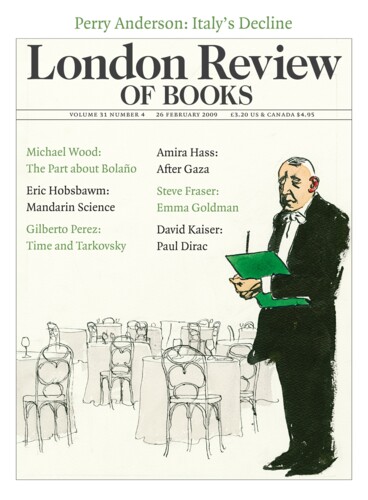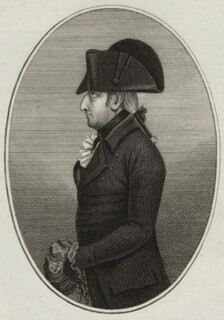Things to read when you’re between boyfriends and being on your own is making you miserable: The Trials of Claus von Bülow, When Husbands Come Out of the Closet, Romola, Hard Times. Wendy Moore’s history of Mary Eleanor Bowes, Countess of Strathmore, might not have been written to make lonelyhearts feel better, but its purpose would otherwise be obscure. The countess was as unimportant as she was wealthy, and though her divorce was granted at a time when divorces were rare, there was little legally significant about it. Moore dedicates the book to her parents ‘in celebration of more than 50 years of marital harmony’, but what follows is a survivor story: what does it signify if you haven’t got a man, so long as you don’t marry a sociopath?
Mary Bowes was the richest heiress in 18th-century Britain, ‘perhaps even Europe’, and so never wanted for suitors. An MP had already tried to kidnap her and force her into marriage before she was 14. The indulged only child of a Yorkshire coal magnate, she was given a boy’s education, and later considered herself to have been a ‘prodigy of learning’: ‘At four years old I could read uncommonly well.’ As a young woman she published a five-act drama, The Siege of Jerusalem, in verse that nearly scans, about Saladin and his betrothed, the unfortunate Princess Erminia, who loves a Christian. Although Linnaean classifications were ‘too smutty’ for English women – all those reproductive organs – she was an ardent botanist, and sent expeditions to Africa, to bring back geraniums.
While other bluestockings might have found themselves unmarriageable, her father’s early death had left her everything, and the very wealthy are allowed their eccentricities. Only a few, like Lord Lyttelton, demurred: ‘As George Bowes’s vanity descends with his estate to his daughter, I don’t wish to see her my daughter-in-law, though she would make my son the richest, and consequently, in her present ideas of greatness, one of the great peers of the Realm.’ In 1767 she married the Ninth Earl of Strathmore, whose family was much in debt, because of his ‘beauty, which was then very great’. She trusted appearances, like all romantics, but when he died she considered it a lucky escape. Lord Strathmore had ridiculed what he called her ‘extreme rage for literary fame’, and during his final illness had written her a scolding letter criticising her wit: she must be less ‘tempted to say an ill-natured thing for the sake of expressing a bon mot’. At 27 Mary Bowes was a widow with five children, a lover, and a fortune that was all her own.
‘Where is the woman who would scruple to be a wife, if she had it in her power to be a widow?’ A married woman’s person, her property and children all belonged to her husband. But a widow could have her own money; she could even run a business. And as for sex, the Georgians were not the Victorians, and aristocrats did not have to behave like the middle class. Mary wrote to at least one man that she had been ‘so unhappy in matrimony that I was determined never to engage myself indissolubly’, but if he would be ‘satisfied with my affection, he would have it’. Abortions were generally considered legal until an 1803 Act of Parliament, and in her widowhood Mary terminated several pregnancies by taking what she described as a ‘black inky kind of medicine’, or when not available, emetic and pepper. But when one of her attempts failed, she reluctantly made preparations for a second marriage to George Gray or Grey, a Scotsman recently returned from India.
Enter the Irish adventurer Andrew Robinson Stoney, a former soldier and ‘villain to the backbone’, by his friends’ accounts. After reading in the Newcastle Chronicle that the earl of Strathmore was dead he headed to London, found lodgings near the countess’s mansion on Grosvenor Square, and set about bribing her servants for information and her friends into providing an introduction. A less confident man might have yielded once Mary’s engagement was announced. But Stoney was bold. Also experienced, having already persuaded one of Newcastle’s wealthiest women to marry him. But she had died – perhaps younger than she might have, had not Stoney locked her ‘in a cupboard in just her underwear … allowing her only an egg a day for sustenance’ – and he had run through most of his inheritance.
In December 1776, Stoney arranged for salacious items to appear anonymously in the press, accusing the countess of ‘cold indifference’ to her late husband’s death, of forsaking her children, and of ‘being frequently made happy (tho’ at different periods) of the bonny, tho’ almost expended Scot, and the Irish widower’. Stoney went to his lady’s defence, demanding satisfaction from the editor of the Morning Post in the traditional manner. (Though duelling was technically illegal, at least 69 men lost their lives that way during the reign of George III.) After the firing of pistols, Stoney lay on the ground, pale and bloodied, and the doctors said his death was imminent. When he asked Mary, as his dying wish, to be married to her, how could she refuse? Poor bluestocking. Years later, she would ask ‘how an unsuspicious young woman … should expect to escape the snares of a wretch?’ The newspaper editor was in on it, the doctors were in on it. The blood was from pigs, the pallor was paint. Stoney was carried on a makeshift bed to his wedding at St James’s, Piccadilly. He took the name Bowes and the countess became his slave. Hearing the story a few decades later from one of Mary’s grandsons, Thackeray would be inspired to write his contribution to rogue literature, The Luck of Barry Lyndon.
Soon after his miraculous recovery, Bowes forbade his wife to leave the house or have visitors without his permission and supervision. Gray (or Grey) threatened to bring an action for breach of contract – engagements were legally binding – but was paid off with £12,000 and died not long afterwards in Bengal. At first, Mary may have consented to her cloistering: she was pregnant by another man, and in order to secure the child’s legitimacy would have to pretend that it had been conceived later than it had been. The baby was hidden for three months, then presented at its baptism as a newborn, which fooled no one. A pamphlet would notice how remarkable it was that Bowes ‘contrives also to have his children brought into the world with teeth, after the manner of Richard III’.
Bowes seems not to have minded claiming the child (‘a small price to pay’, Moore decides, ‘for the spectacular fortune he now possessed’). The other children were sent away to various schools. He obliged Mary to send cutting notes to her friends and relations, which he dictated, saying she would no longer want anything to do with them. The gardeners, on pain of sacking, were made to refuse their mistress access to her hothouses, and released hares to kill her flowers. Other old retainers were replaced by Bowes’s prostitutes. Mary would write that he ‘very soon began to beat me and pinch me, threatening at the same time to kill me if I did not tell my Maid, or any person who observed my bruises, that I had fallen down, or run my head against something’.
An absence in this otherwise thorough book is any meaningful attempt to account for Bowes’s brutality. Did he hate women or hate toffs? Moore writes that he was ‘quite probably psychotic’, though nothing suggests that he suffered delusions or hallucinations. Generally Moore treats him as a slightly nastier version of the typical Georgian husband-despot; ‘broken heads and bloody noses are rather the common consequences of the marriage state,’ a contemporary is quoted as saying. It’s true that 18th-century legal manuals gave husbands permission to beat their wives, since by law they were responsible for their behaviour, but even at the time Bowes was described as extraordinary, a stain on the honour of every feeling Englishman, a speck of barbarity that shocked humanity and outraged civilisation. For Moore, Bowes is simply a good villain – if less interesting than he might be.
If Bowes was mad, he was also savvy, and preferred to keep his worst abuses private. He had an image to protect. A month after the wedding, in February 1777, one of the Members of Parliament for Newcastle died, and Bowes began the first of his attempts to secure office. He stood as a Whig, though whether he had any political convictions is doubtful; historians tell us that his reason for standing was an obsession with obtaining an Irish peerage. He won his seat no more honestly than he had his wife. According to one observer, Mary was made to spend her days in the windows of public houses, ‘from whence she sometimes lets fall some jewels or trinkets, which voters pick up and then she gives them money for returning them – a new kind of offering bribes’. He couldn’t buy everyone, and Moore might have included one of the opposition squibs that equated Newcastle’s voters with Bowes’s abused wife:
We have not yet took him for better for worse;
Alas! She who purchas’d this arm full of woe
Has a bitter bad bargain – then let us say no.
On election day 1780, local Tories were fooled into boarding a pleasure ship in expectation of campaign hospitality. After setting off, Bowes’s captain refused to return to shore until polls had closed, blaming the wind. Once in power, Bowes rarely attended the Commons and is recorded as having voted only once, to oppose a bill ‘to reduce election bribery on the grounds that existing laws were already too severe’.
The wife-beatings had continued all along, but after failing to be re-elected four years later, Bowes developed a new habit. He would force Mary to appear deranged in public: ‘On occasions he would warn her only to reply yes or no to any question, at other times only to say that the weather was hot or cold, and sometimes to refuse to speak at all.’ If she deviated from his instructions, she would receive a special beating. ‘Meanwhile, he presented himself as the aggrieved husband, tenderly attempting to guide his awkward wife.’ It’s too ridiculous, like something out of The Woman in White, but Mary’s fear that her husband was laying the groundwork for her imprisonment in an insane asylum seems all too plausible. He meanwhile was raping nursery maids and beating his valets. What finally brings the story to a close is the hiring of a maid, Mary Morgan, who had the brilliant idea that the countess consult a lawyer.
Mary’s life was only made bearable thanks to ‘the least regarded and least influential members of Georgian society’, as Moore puts it. Maids sneaked Mary food when her husband demanded that she go hungry and lent her their savings. Prostitutes testified on her behalf to Bowes’s cruelty; tenants risked eviction by sending their rents directly to Mary instead of to her husband. Yet more high jinks ensued: Bowes hired a constable to spy on her, kidnapped her and spirited her away to the North, barricaded her in a tower, made her drink poison, perhaps tried to seduce one of her daughters – but how much of one woman’s bad marriage must we be expected to bear?
Only Bowes’s chutzpah keeps the narrative endurable. After Mary filed for divorce through the ecclesiastical courts, Bowes pressed perjury charges against her: ‘She had accused him of locking her in a “dark room” when Bowes claimed it was a “passage”, and of keeping her in a “pig sty”, which Bowes insisted was a “stable yard”.’ He lost, and was imprisoned twice, first for perverting the course of justice, later for debt. After 12 years of marriage, Mary got her divorce on grounds of cruelty and adultery, though the case is perhaps less of a landmark than Moore would like it to be. Wife-torture was still rampant and legal. As late as 1888, husbands could still seize and confine estranged wives; marital rape was legal until 1991. Mary retained her fortune only thanks to a prenuptial deed that she had signed the night before her wedding. Not until the 1870 Married Women’s Property Act were other women allowed to hang on to their own money.
Moore’s biography is more sophisticated and careful than Ralph Arnold’s now 50-year-old Unhappy Countess, but the earlier account has more charm. It begins with the injunction ‘never trust a man with a hyphen’ and ends with the story – it may be spurious – that after her divorce Mary had such a horror of the married state that she ‘virtually imprisoned’ her daughter Anna, ‘refusing to allow her to go to parties or to make any friends with the opposite sex’. She was less protective of her sons, and one, Thomas Bowes Lyon, was a great-great-grandfather of the Queen Mother. Though the world may not have shared Mary’s own opinion on the merits of The Siege of Jerusalem, she still arranged to be buried in Poets’ Corner, near Spenser, and no one has moved her. She spent her last days ‘lavishing attention on her many dogs’, ensuring ‘that each had its own bed and was treated to a hot dinner every day’. Wisdom had come to her.
Send Letters To:
The Editor
London Review of Books,
28 Little Russell Street
London, WC1A 2HN
letters@lrb.co.uk
Please include name, address, and a telephone number.



